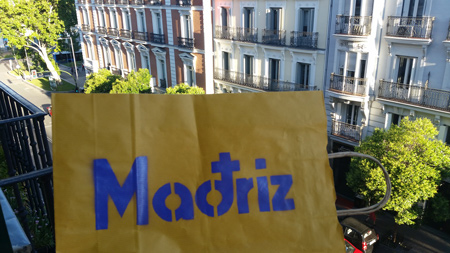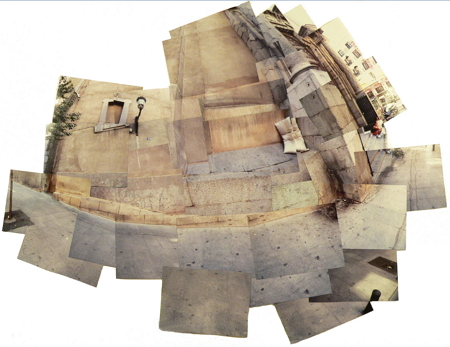MADRID, THE CITY OF WOMEN. INTRODUCING DIVERSITY IN MUSEUMS AND IN CITY. A POLITICAL-EMOTIONAL CARTOGRAPHY
|
Description |
It is a project that aims to show the presence, past and present, from different points of view, of women in the city of Madrid: its historical, social, economic and cultural role, with the aim of showing also the desires and expectations of the women who inhabit Madrid, emphasizing those groups that do not have a voice: women from all social and cultural extracts, indigenous and migrants, from different ethnic groups and backgrounds, with mental health problems, homeless, who have practiced prostitution, young and old, ... the City of Women opens up, like a fan, to show the presence of women as an engine of expression, creativity and activity of the city.

Madrid, Miradas. Dora Román Gil.
Under the umbrella of the European project DIVERCITY, it aims to connect the associative movement, museums, the university and the city. It is a process, but it is also a result, realized thanks to the collaboration of several associations. It is a process, but also a result: a journey, a map, a walk.
It is the result of unique personal experiences, but also, and that is our intention, a response to a precise urban configuration that facilitates or hinders the lives of women and the actions they perform, whether assigned or elected. Does the city help? Does it silence the actions of its citizens? Does it allow to choose? Which shows? Which ones does it hide? What districts are masculinize in Madrid, moving away the women? What areas make the younger women afraid and angry? Which, to the older? What places should we remember? Which ones to forget? What experiences do the women who have just arrived?
The resulting application, "Madrid, City of Women" (MadridFem), for Android and Iphone, in Spanish and English, has received the First Transfer Award of Research in Social Sciences and Humanities in 2017. This project was chosen by the Complutense University to represent him on the European Night of the researchers 2017.
|
How does it work |
The methodology, basic for a horizontal and collaborative process, interacts the following modalities.
- For the current narratives:
Group workshops in associations, intensive workshops with different groups of women, mixed workshops at the Thyssen museum, and two associations together, in-depth interviews, collection and creation of points linked to emotions and narrative itineraries and localization of symbolic spaces through experiences in the city of Madrid.
- For the narratives of women of the past:
Collection of documentation, elaboration of data, elaboration and assembly of video.
- For process evaluation and joint work:
Open days of joint discussion, creation of a website and an interactive map, creation of an application in the mobile that geolocalises the experience of women in the streets of Madrid.
- The project has objectives that favor the empowerment of the groups to which we are addressed:
Promote and make visible the active presence of women in the city of Madrid, both past and present, show the potential of human beings to reflect on living space, habitability, and their capacity for change, promote the exchange, listening and interaction, making cultural spaces agents of change open to citizens, introducing the associative movement in cultural itineraries, merging social and cultural objectives of Madrid.
- According, also, among its objectives beyond the participants:
Show a live Madrid, under construction, where past and present are articulated in equality, encouraging inclusion, make the city a space of possibilities and fight against the stigma of certain social groups.

Sorpresa. Andrea Hauer.
- How is the process articulated?
For several months, we will work in parallel with the different groups, where they will reflect on symbolic and real spaces, within the city of Madrid, from which the participants will express their experiences of inclusion, exclusion, experiences and knowledge of different places of Madrid. The media will be writing, photography, graphic arts, video, among others. The groups are guided by practical art-therapists, educators and/or artists in collaboration with the professionals of each group as support throughout the process.
|
Advantages |
The project supposes the democratization of the urban space of the city through the voices of women, past and present.
|
Where has it been developed |

Enfado. Andrea Hauer.
For several months, we have worked in parallel with different groups, where we have reflected on symbolic and real spaces, within the city of Madrid, from which the participants have expressed their experiences of inclusion, exclusion, experiences and knowledge of different places of Madrid. Some workshops have been long, others short, others, in-depth individual interviews, adapting to the needs and desires of women and collectives. The media have been writing, photography, graphic arts and video.
The groups have been guided by art therapists, educators and/or artists in collaboration with reference professionals of each group as support throughout the process, and museum educators, etc.
It has worked with groups, people and workshops in a separate and joint manner, inviting them to mix and share experiences of the city, and, in later sessions, through meetings and workshops in the Thyssen Bornemisza Museum, where the Museum Turns into a space of encounter, experience and learning shared with the others, has been invited to different groups through the reflection on the images of the city, to establish parallels, criticisms, antagonisms and shared utopias.
During several sessions, it has been reflected on the idea of the city, real and symbolic, about living and belonging, inviting the participants to think of places in Madrid as spaces of experience.
Associations involved: Museo Thyssen-Bornemisza; Center for Psychosocial Rehabilitation La Latina, group 5, Community of Madrid; Puerta Abierta, group 5, Community of Madrid; Hetaira Collective; Women in the Visual Arts; Teután Adult Education Center; Commission Maltreatment; Master's Degree in Art Therapy U.C.M.
Museums and cultural centers: Museo Thyssen-Bornemisza; Matadero Madrid, Intermediae; Tabacalera, Ministry of Culture; La Casa Encendida.
Universities: “R&D Applications of art in social integration: art, therapy and education for diversity". Since 2010 it has been called from agencies, other national and international research groups, publishers, municipalities and various institutions to organize art programs and psychosocial inclusion and art and coeducation. Its different members are required in different opinion forums, both as pioneers in the formation of art and therapy in Spain and have transformed it into an official master's degree and publications.
From the impact of his latest publications (teachers' guides through which equity is worked through creation, individual and collective books, book chapters, research journal Art Therapy and Artistic Education for Social Inclusion), is required from various public and private institutions to collaborate in the design of materials and plans that include artistic creation as a means for the introduction of values in education as well as the introduction of groups with special needs in museums. The group have published ten issues of the research journal Art Therapy. Several members of the group have been required to organize a virtual exhibition in CERES, belonging to the Ministry of Culture, with funds from the State Museums Network.
Several members of the group have been required to organize a virtual exhibition in CERES, belonging to the Ministry of Culture, with funds from the State Museums Network.
|
And also |
The members of the group have obtained from the European commission the project ARIADNE, Art and Adaptation in Intercultural Enviroments as partner and led by the organization Elan Interculturel in order to: pour the results of the project and insert them into an international project; adapt them to the migrant groups; contribute to making a European good practice manual; design pilot projects and validate them to propose valid methodologies in Europe.
The group has obtained the DIVERCITY project from the European Commission. Through this project will produce indicators on diversity and art, a catalog of good practices will be developed; Methodologies valid for art and inclusion, and will be implemented through workshops. All this will be disseminated in several languages and through various materials in different languages. It has obtained the project ALETHEIA: Art, arttherapy, trauma and emotional memory.
Rosa Regas 2010 Prize, Andalusian Council for the publication and coordination of the collection "Possibilities of being through art" by Eneida publishing house, by 21 educational guides on art, education and equality.
At present it is part of the MUSacces consortium, whose objective is to improve the accessibility of the Prado Museum's heritage through integrating museographic discourses and technological applications to facilitate interaction between the museum and groups with specific needs: blind, deaf and inmate.
|
Contact |
|
© Office for the Transfer of Research Results – UCM |
|
PDF Downloads |
|
Classification |
Political Science and Sociology
|
Responsible Researcher |
Marian López Fernández Cao: asevrrii@ucm.es
Department: Didactics of Plastic Expression
Faculty: Education


